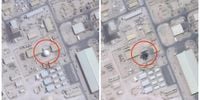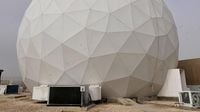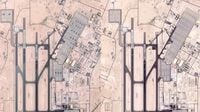On June 23, 2025, Al Udeid Air Base in Qatar, a critical hub for U.S. military operations in the Middle East, was struck by an Iranian ballistic missile, marking the first confirmed direct hit on the sprawling facility during a retaliatory attack. Satellite images analyzed by The Associated Press and other news organizations reveal that the missile targeted a geodesic dome housing the Modernized Enterprise Terminal (MET), a $15 million communications suite integral to secure U.S. military communications.
For years, Al Udeid Air Base has served as the forward headquarters for U.S. Central Command (CENTCOM) and U.S. Air Forces Central, hosting approximately 10,000 military and civilian personnel. The MET, installed in 2016, is a sophisticated radome that protects a satellite dish providing voice, video, and data services, linking service members across the CENTCOM area of responsibility with military leaders worldwide. This terminal also features anti-jamming technology, underscoring its strategic importance.
According to Pentagon spokesperson Sean Parnell, who officially acknowledged the missile strike on July 11, 2025, "One Iranian ballistic missile impacted Al Udeid Air Base June 23 while the remainder of the missiles were intercepted by U.S. and Qatari air defense systems." He emphasized that the missile strike "did minimal damage to equipment and structures on the base" and that "there were no injuries." Parnell assured that "Al Udeid Air Base remains fully operational and capable of conducting its mission, alongside our Qatari partners, to provide security and stability in the region."
Satellite images from Planet Labs PBC and Satellogic, reviewed by outlets such as Iran International and the Associated Press, show the geodesic dome intact just hours before the attack on the morning of June 23. Subsequent images taken on June 24 and 25 reveal the dome reduced to a blackened smear with visible burn marks, while nearby buildings show minor damage. The rest of the base appears largely untouched, illustrating the precision of the strike or the effectiveness of the base’s defensive measures.
The attack was Iran’s response to a U.S. military operation two days earlier—dubbed "Operation Midnight Hammer"—in which multiple U.S. Air Force B-2 bombers and U.S. Navy ships targeted three Iranian nuclear sites at Fordow, Natanz, and Isfahan. The B-2s dropped 14 GBU-57 bunker buster bombs, including on the heavily fortified underground complex at Fordow, aiming to degrade Iran’s nuclear enrichment capabilities. Pentagon officials have since assessed that the operation set back Iran’s program by one to two years.
Iran’s missile barrage on Al Udeid included short- and medium-range ballistic missiles, launched either directly from Iran or via proxy forces. The base is located just across the Persian Gulf from Iran, making it a logical target. The U.S. and Qatar had prepared extensively for the attack; intelligence reports indicated Iran’s intention, allowing American and Qatari forces to ready their air defenses. This preparation included relocating most aircraft and personnel off the base, extending security perimeters, and deploying additional Patriot missile batteries transferred from Japan and Korea.
The defense systems proved largely effective. American and Qatari Patriot missile batteries intercepted 13 of the 14 incoming missiles. President Donald Trump, who visited Al Udeid on May 15 as part of his Middle East tour, described the retaliatory strike as a "very weak response" on his Truth Social platform. He wrote, "13 (missiles) were knocked down, and 1 was ‘set free,’ because it was headed in a nonthreatening direction." Trump expressed gratitude to Iran for providing early warning, stating, "I want to thank Iran for giving us early notice, which made it possible for no lives to be lost, and nobody to be injured." He also noted that no Qataris were harmed during the attack.
Despite the Pentagon’s confirmation of damage, Trump downplayed the impact, asserting that "hardly any damage was done." However, his comments left room for acknowledging some damage, particularly to the communications dome. The Pentagon’s Sean Parnell echoed this, noting the damage was "minimal." The London-based satellite news channel Iran International was the first to report on the damage, using satellite images that clearly showed the dome’s destruction.
Iran, on the other hand, lauded the attack as a significant success. The Islamic Revolutionary Guard Corps described Al Udeid as the "target of a destructive and powerful missile attack," while Iran’s Supreme National Security Council claimed the base had been "smashed." Meanwhile, Ahmad Alamolhoda, an adviser to Iran’s Supreme Leader Ayatollah Ali Khamenei, asserted that the base’s communications were completely cut, stating, "All equipment of the base was completely destroyed and now the U.S. command stream and connection from Al Udeid base to its other military bases have been completely cut." These claims, however, contrast with satellite imagery and Pentagon statements indicating limited damage confined to the radome and a nearby building.
Defense analysts have speculated that Iran may have employed a bomb-carrying drone to penetrate Al Udeid’s air defenses, which were primarily focused on intercepting ballistic missiles. This theory arises from the limited damage to surrounding structures, suggesting a precise strike rather than widespread missile impact. Farzin Nadimi, a defense and security analyst at the Washington Institute, noted that two U.S. Army Patriot systems and several Qatari batteries were responsible for defending the base, and that the defenders had just about two minutes to respond to the attack. Nadimi added that an Iranian drone could have slipped through while the Patriot batteries were busy intercepting missiles.
U.S. Air Force General Dan Caine, chairman of the Joint Chiefs of Staff, described the defense of Al Udeid as the "largest single Patriot engagement in U.S. military history." He detailed the chaotic environment during the attack, saying, "There was a lot of metal flying around, between attacking missiles being hit by Patriots, boosters from attacking missiles being hit by Patriots, the Patriots themselves flying around, and the debris from those Patriots hitting the ground." Despite the complexity, Caine praised the air defenders’ rapid and strategic decision-making.
The Iranian missile attack on Al Udeid came amid a volatile period in the Middle East, coinciding with a 12-day war between Iran and Israel. Israeli forces had conducted extensive airstrikes against Iranian nuclear and military sites, targeting senior commanders, while Tehran retaliated with hundreds of missiles and drones aimed at Israel. The attack on Al Udeid, however, did not escalate into a broader regional conflict. Instead, it prompted U.S. President Donald Trump to broker a ceasefire between Iran and Israel, which has held since.
The damage to Al Udeid Air Base, while symbolically significant, did not impair the base’s operational capacity. The U.S. military continues to operate from the base alongside Qatari partners, maintaining security and stability in the region. The attack underscored the persistent threat posed by Iran’s missile capabilities and highlighted the importance of robust missile defense systems and intelligence sharing between allies.
In the aftermath, the U.S. Department of Defense continues to assess the full impact of both the Iranian retaliatory strike and the preceding Operation Midnight Hammer on Iran’s nuclear program. The satellite images and Pentagon acknowledgments provide a rare glimpse into the physical consequences of a high-stakes confrontation that, fortunately, did not spiral into wider conflict.



